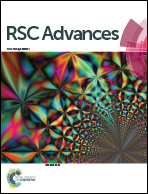A porous CuO nanowire-based signal amplification immunosensor for the detection of carcinoembryonic antigens†
Abstract
A novel electrochemical immunosensor was developed for carcinoembryonic antigens (CEA) based on gold nanoparticle load carbon nanotubes (CNTs–AuNPs) as an immunosensor platform and porous CuO nanowire supported ferrocene (pCuOw@Fc) as signal amplification labels. The pCuOw were prepared by a simple decomposition of the Cu(OH)2 precursor. The products were characterized using transmission electron microscopy (TEM), X-ray diffraction (XRD) and Fourier transform infrared spectroscopy (FT-IR). The electrochemical performance of the resulting immunosensor was investigated by cyclic voltammetry (CV), and the electrochemical immunosensor showed enhanced electrochemical performance toward the detection of CEA with a range from 0.005 ng mL−1 to 80 ng mL−1 and a detection limit of 0.0008 ng mL−1 (S/N = 3). The proposed immunosensor was successfully used in determining the CEA in real samples and holds great potential for the sensitive electrochemical biosensing of other analytes.


 Please wait while we load your content...
Please wait while we load your content...